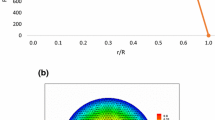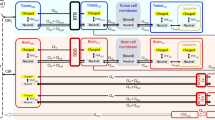Abstract
It is apparent that chemotherapy against malignant brain tumors is generally ineffective. While some agents are more effective than others, none appreciably alters the clinical course of and the poor prognosis for patients with brain tumors. Even though new and more effective agents are being or will be developed, chemotherapy depends as much on the delivery of drug as it does on the drug used. Therefore, we have defined factors that we believe are of primary importance in drug delivery to brain tumors, and, using computer simulation, we have modeled the effects of these factors. In this article we discuss (a) the extent of the “breakdown” in the blood-brain barrier (BBB) that accompanies the development of malignant tumors in the brain, (b) factors that influence drug transport from tumor capillaries to tumor cells at varying distances from the capillaries, (c) the problems inherent in drug delivery from a well-vascularized tumor outward to normal brain tissue that might harbor malignant cells but that does not have leaky vessels (i.e., normal BBB), and (d) the difficulties in drug delivery from a well-perfused, highly permeable outer tumor shell to a central, poorly perfused tumor core.
Similar content being viewed by others
References
V. A. Levin and C. B. Wilson. Chemotherapy: Agents in current use.Sem. Oncol. 2:63–67 (1975).
R. I. Geran, G. F. Congleston, and L. E. Dudeck. A mouse ependymoblastoma as an experimental model for screening potential antineoplastic drugs.Cancer Chemother. Rep. 4:53–87 (1974).
V. A. Levin and P. M. Kabra. Effectiveness of the nitrosoureas as a function of their lipid solubility in the chemotherapy of experimental rat brain tumors.Cancer Chemother. Rep. 58:787–792 (1974).
J. D. Fenstermacher, D. P. Rall, C. S. Patlak, and V. A. Levin. Ventriculocisternal perfusion as a technique for analysis of brain capillary permeability and extracellular transport. InCapillary Permeability, Munksgaard, Copenhagen, 1970, pp. 483–490.
C. S. Patlak and J. D. Fenstermacher. Measurement of dog blood-brain barrier transfer constants by ventriculocisternal perfusion.Am. J. Physiol. 229:877–884 (1975).
E. J. Schantz and M. A. Lauffer. Diffusion measurements in agar gel.Biochemistry 1:658–663 (1962).
R. J. Weinkam and H.-S. Lin. Direct reaction mixture analysis by probe intersection chemical ionization mass spectrometry.Anal. Chem. 51:972–975 (1979).
R. G. Blasberg, C. S. Patlak, and J. D. Fenstermacher. Intrathecal chemotherapy: Brain tissue profiles after ventriculo-cisternal perfusion.J. Pharmacol. Exp. Ther. 195:73–83 (1975).
V. A. Levin, J. D. Fenstermacher, and C. S. Patlak. Sucrose and inulin space measurements of cerebral cortex in four mammalian species.Am. J. Physiol. 219:1528–1533 (1970).
V. A. Levin, H. D. Landahl, and M. A. Freeman-Dove. The application of brain capillary permeability coefficient measurements of pathologic conditions and the selection of agents which cross the blood-brain barrier.J. Pharmacokin. Biopharm. 4:499–519 (1976).
V. A. Levin, M. S. Edwards, and A. Byrd. Quantitative observations of the acute effects of X-irradiation on brain tumor capillary permeability.Int. J. Radiat. Oncol. Biol. Phys. 5:1627–1631 (1979).
V. A. Levin, P. M. Kabra, and M. A. Freeman-Dove. Relationship of 1,3-bis(2-chloroethyl)-1-nitrosourea (BCNU) and 1-P-chloroethyO-S-cyclohexyl-1-nitrosourea (CCNU) pharmacokinetics to uptake, distribution, and tissue/plasma partitioning in rat organs and intracerebral tumors.Cancer Chemother. Pharmacol. 1:233–242 (1978).
V. A. Levin and M. Chadwick. Distribution of 5-fluorouracil-2-14C and its metabolites in a murine glioma.J. Natl. Cancer Inst. 49:1577–1584 (1972).
V. A. Levin, M. A. Freeman-Dove, and C. E. Maroten. Dianhydrogalactitol (NCS-132313) pharmacokinetics in normal and tumor bearing rat brain and antitumor activity against three intracerebral rodent tumors.J. Natl. Cancer Inst. 56:535–539 (1976).
P. A. Harris and J. F. Gross. Preliminary pharmacokinetic model for adriamycin.Cancer Chemother. Rep. 59:819–825 (1975).
P. G. W. Plagemann, R. Marz, and R. M. Wohlhueter. Transport and metabolism of deoxycytidine and 1-3-d-arabino-furanosyl-cytosine into cultured Novikoff rat hepatoma cells, relationship to phosphorylation, and regulation of triphosphate synthesis.Cancer Res. 38:978–989 (1978).
V. A. Levin, M. A. Freeman-Dove, and H. D. Landahl. The permeability characteristics of the brain adjacent to intracerebral rodent tumors.Arch. Neurol. 32:785–791 (1975).
R. G. Blasberg, C. S. Patlak, W. R. Shapiro, and J. D. Fenstermacher. Metastatic brain tumors: Local blood flow and capillary permeability.Neurology (Minneapolis) 29:547 (1979) (abstr.).
N. A. Vick and D. Bigner. Microvascular abnormalities in virally induced canine brain tumors.J. Neurol. Sci. 17:29–39 (1972).
V. A. Levin, D. C. Wright, H. D. Landahl, C. S. Patlak, and J. Csejtey.In situ drug delivery.Br. J. Cancer 41:74–78 (1980) (Suppl. IV).
A. Krogh.The Anatomy and Physiology of Capillaries, Yale University Press, New Haven, 1929.
D. G. Levitt. Theoretical model of capillary exchange incorporating interaction between capillaries.Am. J. Physiol. 220:250–255 (1972).
P. M. Gullimo and F. M. Grantham. Studies on the exchange of fluids between host and tumor. II. Blood flow studies of hepatomas and other tumors in rats and mice.J. Natl. Cancer. Inst. 27:1465–1491 (1960).
E. Siracka, N. Poppova, V. Pipa, and J. Durkovsky. Changes in blood flow of growing experimental tumor determined by the clearance of133Xe.Neoplasma 26:173–177 (1979).
J. D. Weinstein, F. J. Toy, M. E. Jaffe, and H. I. Goldgerg. The effects of dexamethasone on brain edema in patients with metastatic brain tumors.Neurology (Minneapolis) 23:121–129 (1973).
D. Norman, W. Berninger, D. Boyd, V. A. Levin, and T. H. Newton. Dynamic computed tomography. Presented at the XIth Symposium Neuroradiologicum, 4–10 June, 1978, Wiesbaden, West Germany (abstr.).
K. T. Wheeler, E. F. Tel, M. E. Williams, S. Sheppard, V. A. Levin, and P. M. Kabra. Factors influencing the survival of rat brain tumor cells afterin vitro treatment with 1,3-bis(2-chloroethyl)-1-nitrosourea.Cancer Res. 35:1464–1469 (1975).
V. A. Levin, J. Stearns, A. Byrd, A. Finn, and R. J. Weinkam. The effect of phenobarbital pretreatment on the antitumor activity of 1,3-bis(2-chloroethyl)-1-nitrosourea (BCNU), 1-(2-chloroethyl)-3-cyclohexyl-1-nitrosourea (CCNU), and 1-(2-chloroethyl)-3-(2,6-dioxo-3-piperidyl)-1-nitrosourea (PCNU), and on the plasma pharmacokinetics and bio-transformation of BCNU.J. Pharmacol. Exp. Ther. 208:1–7 (1979).
R. J. Weinkam, T.-Y. Liu, and H.-S. Lin. Protein mediated chemical reactions of chloroethylnitrosoureas.Chem. Biol. Interact. (in press).
M. R. Rosenblum, K. T. Wheeler, C. B. Wilson, M. Barker, and K. D. Knebel.In vitro evaluation ofin vivo brain tumor chemotherapy with 1,3-bis(2-chloroethyl)-1-nitrosourea.Cancer Res. 35:1387–1391 (1975).
V. A. Levin, K. T. Wheeler, and C. B. Wilson. Chemotherapeutic approaches to brain tumors: Clinical and experimental observations with dianhydrogaiactitol and dibromodulcitol.Cancer Treat. Rep. (in press).
P. Espana, P. H. Wiernik, and M. D. Walker. Phase II study of dianhydrogaiactitol in malignant glioma.Cancer Chemother. Rep. 62:1199–1200 (1978).
J. I. Ausman, V. A. Levin, W. E. Brown, D. P. Rall, and J. D. Fenstermacher. Brain tumor chemotherapy: Pharmacologic principles derived from a monkey tumor model.J. Neurosurg. 46:155–164 (1977).
M. G. Donelli, M. Broggini, T. Colombo, and S. Garattini. Importance of the presence of necrosis in studying drug distribution within a tumor tissue.Ear. J. Drug Metabol. Pharmacokin. 2:63–67 (1977).
R. J. Goldacre. Viable tumor regions accessible to chemotherapeutic agents and a possible new strategy for inactivating them.Br. J. Cancer 36:406 (1977).
V. A. Levin. Relationship of octanal/water partition coefficients and molecular weight to rat brain capillary permeability.J. Med. Chem. 23:682–684 (1980).
I. F. Tannock. The relation between cell proliferation and the vascular system in a transplanted mouse mammary tumor.Br. J. Cancer 22:258–273 (1968).
H. S. Carslaw and J. C. Jaeger,Conduction of Heat in Solids, 2nd ed., Oxford University Press, New York, 1959, pp. 63, 247.
T. Hoshino, C. B. Wilson, M. L. Rosenblum, and M. Barker. Chemotherapeutic implication of growth fraction and cell cycle time in glioblastoma.J. Neurosurg. 43:127–137 (1975).
N. A. Lassen and W. A. Perl.Tracer Kinetic Methods in Medical Physiology. Raven Press, New York, 1979.
J. J. Blum. Concentration profiles in and around capillaries.Am. J. Physiol. 198:991–998 (1960).
S. Kety. The theory and application of the exchange of inert gas at the lungs and tissues.Pharmacol. Rev. 3:1–41 (1951).
Author information
Authors and Affiliations
Additional information
This work was supported by American Cancer Society Grant CH-75 and NIH Program Project Grant CA-13525. V. A. L. is the recipient of an American Cancer Society Faculty Research Award (FRA-155).
Rights and permissions
About this article
Cite this article
Levin, V.A., Patlak, C.S. & Landahl, H.D. Heuristic modeling of drug delivery to malignant brain tumors. Journal of Pharmacokinetics and Biopharmaceutics 8, 257–296 (1980). https://doi.org/10.1007/BF01059646
Received:
Revised:
Published:
Issue Date:
DOI: https://doi.org/10.1007/BF01059646




